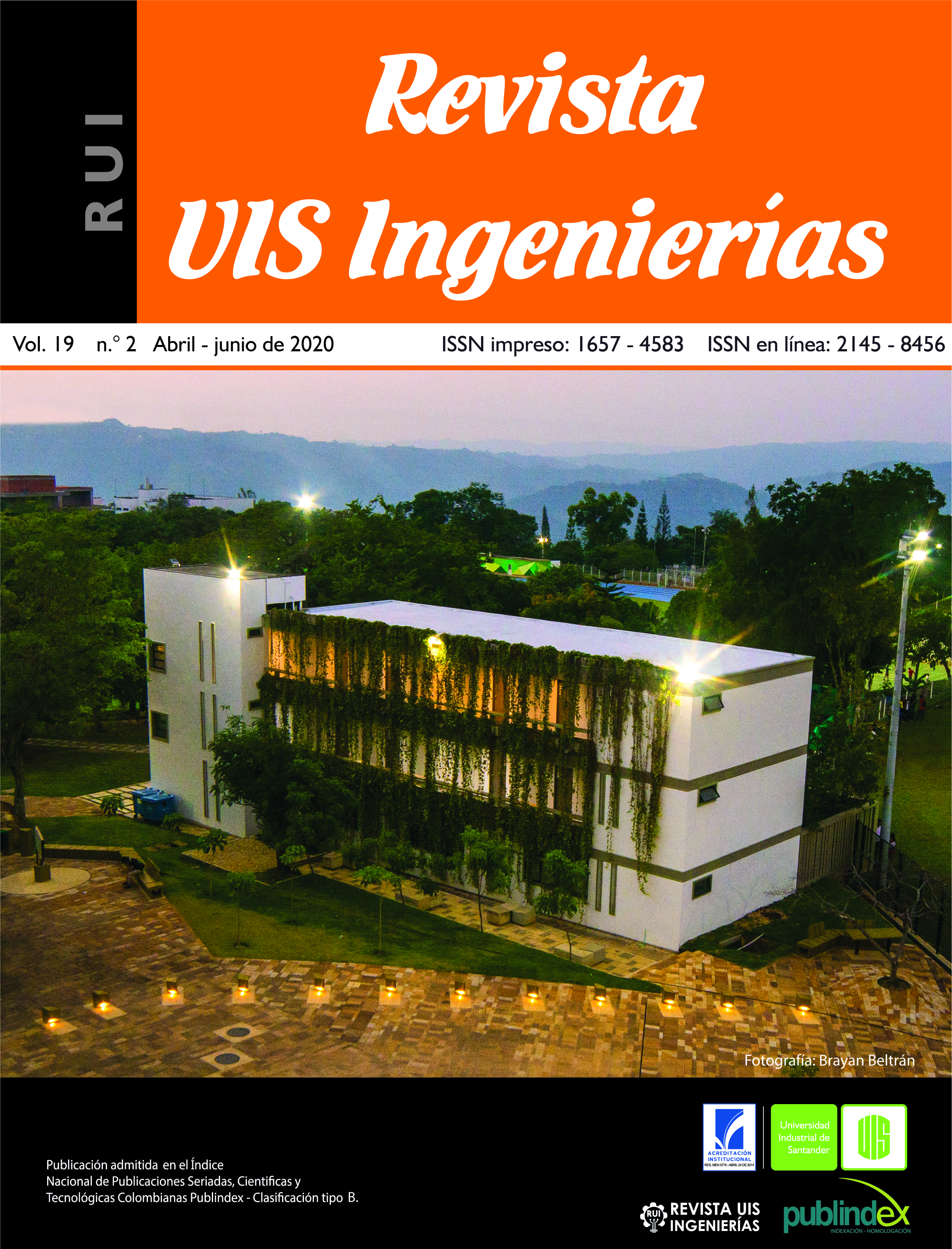Design and test with Hardware-in-the-Loop (HIL) of dynamics controllers for an agricultural robot
Published 2020-03-16
Keywords
- agriculture,
- mobile robotics,
- modelling,
- automatic guidance,
- embedded systems
- differential robot ...More
How to Cite
Copyright (c) 2020 Revista UIS Ingenierías

This work is licensed under a Creative Commons Attribution-NoDerivatives 4.0 International License.
Abstract
Due the worldwide growing food demand, efforts toward to resource optimization in crops, are required. With this purpose, the use of technology is a big chance to deal these challenges, with the aim of automatizing agricultural processes. Within the tasks in agriculture, by example wedding, supply fertilizers or fungicides, the mobile robots have a potential use to assist these tasks. Then, from this work, velocity control of a differential mobile platform is developed, in order to perform precision agriculture tasks. Specifically, mathematical modelling, design of state feedback control and the integration to the robot hardware, through Hardware in the loop (HIL) simulations, validation test are performed by using ROS environment, embedded devices and mathematical simulations, at previous stage to real test. Showing a full integration of the proposed system to test and prove mobile robots.
Downloads
References
[2] Y. Nagasaka, N. Umeda, Y. Kanetai, K. Taniwaki, Y. Sasaki, “Autonomous guidance for rice transplanting using global positioning and gyroscopes,” Comput. Electron. Agric., vol. 43, no. 3, pp. 223–234, doi: 10.1016/j.compag.2004.01.005
[3] B. T. van Zanten et al., “European agricultural landscapes, common agricultural policy and ecosystem services: a review,” Agron. Sustain. Dev., vol. 34, no. 2, pp. 309–325, 2014, doi:10.1007/s13593-013-0183-4
[4] S. A. Hiremath, G. W. A. M. van der Heijden, F. K. van Evert, A. Stein, C. J. F. Ter Braak, “Laser range finder model for autonomous navigation of a robot in a maize field using a particle filter,” Comput. Electron. Agric., vol. 100, pp. 41–50, doi: 10.1016/j.compag.2013.10.005
[5] Avital Bechar, “Robotics in horticultural field production,” Stewart Postharvest Rev., vol. 6, no. 3, pp. 1–11, 2010, doi: 10.2212/spr.2010.3.11
[6] K. H. Choi, S. K. Han, S. H. Han, K.-H. Park, K.-S. Kim, S. Kim, “Morphology-based guidance line extraction for an autonomous weeding robot in paddy fields,” Comput. Electron. Agric., vol. 113, pp. 266–274, 2015, doi: 10.1016/j.compag.2015.02.014
[7] S. N. Young, E. Kayacan, and J. M. Peschel, “Design and field evaluation of a ground robot for high-throughput phenotyping of energy sorghum,” Precis. Agric., vol. 20, no. 4, pp. 697–722, 2019, doi: 10.1007/s11119-018-9601-6
[8] P. F. Martin Gomez, O. S. Hernandez Mendoza, “Fertilizer dosage vehicle via global positioning system with technology for small productions,” in 2014 III International Congress of Engineering Mechatronics and Automation (CIIMA), 2014, pp. 1–5, doi: 10.1109/CIIMA.2014.6983457
[9] A. Koubaa, Ed., Robot Operating System (ROS), vol. 625. Cham: Springer International Publishing, 2016.
[10] H. W. Griepentrog, C. L. Dühring Jaeger, D. S. Paraforos, “Robots for Field Operations with Comprehensive Multilayer Control,” KI - Künstliche Intelligenz, vol. 27, no. 4, pp. 325–333, 2013, doi: 10.1007/s13218-013-0266-z
[11] Z. Wang, L. Gong, Q. Chen, Y. Li, C. Liu, Y. Huang, “Rapid Developing the Simulation and Control Systems for a Multifunctional Autonomous Agricultural Robot with ROS,” 2016, pp. 26–39.
[12] J. Khan, “A Standardized Process Flow for Creating and Maintaining Component Level Hardware in the Loop Simulation Test Bench,” in SAE Technical Papers, 2016, vol. 2016-April, no. April, doi: 10.4271/2016-01-0052
[13] P. Wältermann, H. Schütte, K. Diekstall, “Hardware-in-the-loop testing of Distributed Electronic Systems,” ATZ Worldw., vol. 106, no. 5, pp. 6–10, May 2004, doi: 10.1007/BF03224664
[14] C. Liu, B. Chen, M. Cheng, A. Champagne, K. Patel, “Model Integration and Hardware-in-the-Loop (HiL) Simulation Design for the Testing of Electric Power Steering Controllers,” SAE Technical Papers, 2016, doi: 10.4271/2016-01-0029.2016
[15] S. Taheri, C. Sandu, S. Taheri, E. Pinto, D. Gorsich, “A technical survey on Terramechanics models for tire–terrain interaction used in modeling and simulation of wheeled vehicles,” J. Terramechanics, vol. 57, pp. 1–22, 2015, doi: 10.1016/j.jterra.2014.08.003
[16] L. Ljung, “System Identification,” in Wiley Encyclopedia of Electrical and Electronics Engineering, Hoboken, NJ, USA: John Wiley & Sons, Inc., 2017, pp. 1–19, doi: 10.1002/047134608X.W1046

